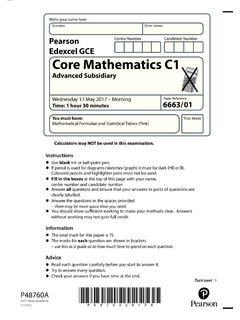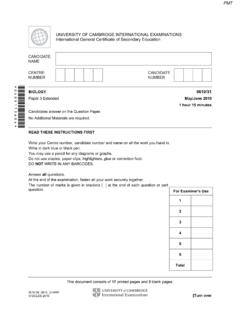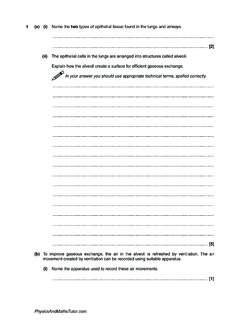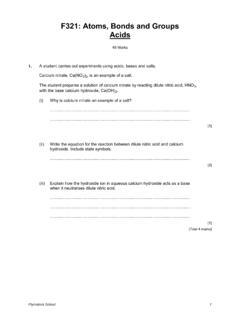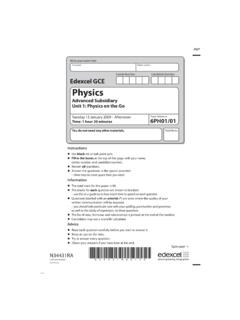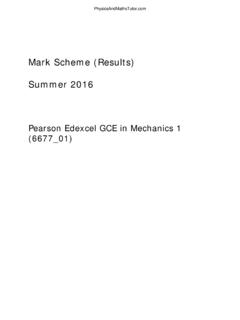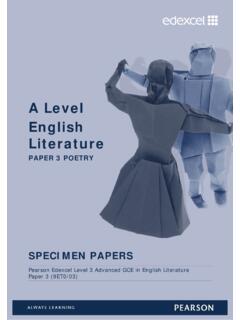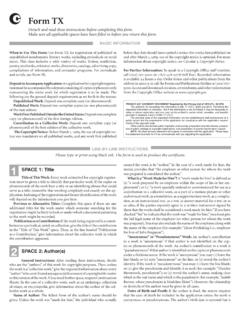Transcription of AQA English GCSE Poetry: Love and Relationships - PMT
1 AQA English GCSE poetry : Love and Relationships Sonnet 29 - I think of thee! - Elizabeth Barrett Browning work by PMT Education is licensed under CC BY-NC-ND 29 - I THINK OF THEE Elizabeth Barrett Browning Brief Summary Sonnet 29 is a poem about the speaker s borderline obsessive thoughts about their lover. The idea of vines encircling a tree is used as a metaphor for the speaker s growing love. Eventually they realise that it is better to be physically present rather than thinking about him. Synopsis The speaker begins by stating how their thoughts wrap around their lover like vines around a tree B arrett Browning develops this metaphor further by describing the effect of the speaker s thoughts Eventually the speaker comes to the conclusion that now they are physically close with their lover, they no longer feel these overwhelming thoughts.
2 Context Elizabeth Barrett Browning (1806-1861) She wrote this whilst courting Robert Browning so it is thought to be written about him. It was published in a collection of 44 sonnets called Sonnets from the Portuguese which are all thought to be written for him. The poems were written during their courtship rather than after their marriage; she didn t show him the poems until years after they married showing how they were written for Barrett Browning herself rather than for a public audience. By writing about such a high-profile individual in the 1800s publicly, it would have created a heightened sense of tension around the collection. Her father did not allow marriage so they met in secret, wrote hundreds of letters to each other and eventually eloped.
3 When she married Robert, she was cut off from her family - she was six years Robert s senior. Both herself and Robert experienced enough success to live comfortably during their lives. Barrett Browning was known to be socially conscious and vocal about the issues of child labour and slavery. During the Victorian era, women were expected to not experience or express strong emotions so the end of the poem may be representative of her casting off these restraints and is generally representative of a rebellion from the gender expectations she was bound to. Barrett Browning was also known to be bedridden for large parts of her life- this could be why she is writing about thinking about people rather than being with them. title I think of thee! Perspective It is commonly assumed that Barrett Browning herself is the speaker of the poem.
4 By being in the first person , the poem is made more personal. As only the speaker s voice is heard, her obsessive nature is highlighted. Although it is a sonnet and directed at the speaker s lover, the intimate personal nature of the poem gives the impression of it being written for herself rather than for him to read. Sonnet 29- I think of thee! The poem consists of an extended metaphor, he is a tree and her thoughts about him are a vine. Her use of an exclamation mark shows the depth of her feelings, and may also appear defensive - perhaps as a response to an accusative letter. By directly addressing the poem at her lover, it is being set up as a personal poem initially, making it a more intimate love poem. She has thought about him so much that she can no longer see him really, she can only see the image she has created of him.
5 There s nought to see also implies that she is unable to think about anything other than him. Her use of the pronoun my shows their dependency on each other. Palm tree is an odd choice of metaphor, however it has excotic and biblical connotations, so this may be representative of either the novelty of timeless nature of their relationship. The auditory imagery used here has natural connotations, implying the inevitability of their love for each other. I think of thee! my thoughts do twine and bud About thee, as wild vines , about a tree, Put out broad leaves, and soon there 's nought to see Except the straggling green which hides the wood . Yet, O my palm-tree, be it understood I will not have my thoughts instead of thee Who art dearer, better!
6 Rather, instantly Renew thy presence; as a strong tree should, Rustle thy boughs and set thy trunk all bare, And let these bands of greenery which insphere thee Drop heavily down, burst, shattered, everywhere! Because, in this deep joy to see and hear thee And breathe within thy shadow a new air, I do not think of thee I am too near thee . Her growing thoughts are beginning to feed off of him and become detrimental. Tree and thee sets up an internal rhyme which makes the relationship appear more harmonious. hides the wood implies that she is worried that their love for each other will conceal their true selves. Alliterative sibilance is used in thoughts and thee to create a negative tone towards the beginning of the poem. Her thoughts are presented to be suffocating.
7 She eventually breaks free of her obsessive thoughts and they are able to love each other. This use of triadic structure marks a turning point in the poem. Opening The rain set early in to-night, The sullen wind was soon awake, It tore the elm-tops down for spite, and did its worst to vex the lake: I listened with heart fit to break. When glided in Porphyria; straight The first stanza begins with a heavy emphasis on the weather. Browning personifies the weather by describing the wind as sullen as well as trying to vex the lake and tear the elm-tops down for spite . This use of pathetic fallacy sets an ominous tone which foreshadows the coming horrific events. This tone is then shattered by the entrance of Porphyria who is given supernatural traits by the description of her having glided into the cottage.
8 Turning point There is a turning point at line 11 - Because, in this deep joy to see and hear thee - after which the speaker changes from thinking about her lover to being with him. This does not conform to the traditional sonnet form in which the turning point from problem to solution is usually in line 9. Structure and form Sonnet form The poem is in the form of a petrarchan sonnet : there are two quatrains and one sestet , with each line employing ten syllables - five stressed and five unstressed. This means it is in iambic pentameter. Though, by writing in a traditional format such a sonnet in iambic pentameter , she is suggesting the traditional nature of her love. At times she breaks from the constraints of iambic pentameter in the line put out broad leaves, and soon there s nought to see.
9 This highlights the unconventionality of their love as well as implying that the love she feels is so intense that she must express it in any way rather than worrying about rigid guidelines. The pronouns thee and thy are repeated frequently throughout in order to reinforce the fact that the poem is directed to somebody Traditionally, the first stanza presents the speaker s problem which in Sonnet 29 is Barrett Browning s overwhelmingly intense feelings of love towards Robert. The poem then ends with a solution which here is her moving from thinking about him to being with him. Barrett Browning s non conformist attitude is shown in her choice of form as originally the sonnet was intended to be written by a man to a woman. Volta In traditional sonnets there is a volta after the eighth line which is used to change the tone or mood.
10 However, in Sonnet 29, the volta is found in line five which starts with yet . Here, it could argued that she is reflecting the nontraditional and non-conformist attitude of the poem by breaking tradition and hosting her volta earlier in the poem. Rhyme scheme The rhyme scheme of the poem is ABBCCBBCDBDBDB this is more typical of the Italian style of sonnet writing rather than English so shows the slight unconventionality of her affections. At her time of writing the English , Shakespearean style sonnet was more popular however, these generally focussed on physical affection whilst petrarchan sonnets are usually centred on prospective love from a distance. Language Intimate language Barrett Browning s use of language creates the impression of intimacy between the speaker and her lover.

